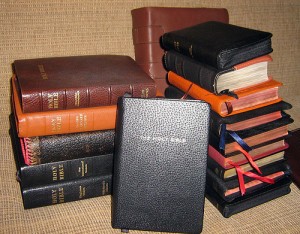Which Bible do we use?
Quite a few! Some are better than others for reading or studying. What am I able to read and understand? What will I actually read, as opposed to leave sitting on the bedside table? The Bible has been translated into over 75 different translations! Many countries don’t have a Bible in their own language. But before we go there, let’s take a quick look at the different types of translations.
Some people are confused by the various translations on offer. In summary, there are two types:
Actual Translations.
These are translated from the Hebrew test of the Old Testament and the Greek text of the New Testament. These are Bible such as, King James Bible, Revised Version, and the Revised Standard Version. Then, there are other translations which were very carefully translated such as, The New English Bible, The Good News Bible, and The New International Version.
Paraphrased Translations
Paraphrased Translations such as the Living Bible, The Message and the Amplified Bible can be beneficial for understanding the richness of God’s Word by using modern vocabulary, but not for study. Don’t use these types for Bible Study.
Types of Bibles:
Each translation comes in different formats. There are Study Bibles, Devotional Bibles, and more. A Study Bible has notes and explanations which can be very helpful. Some Bibles have a concordance built in with it. Many Bibles contain historical and geographical maps but these individual reference books can also be purchased separately.
 Want more? Read on…
Want more? Read on…
When translating from the original language (Hebrew/Aramaic/Greek) to the Receptor language (in our case, English) there are three ways in which translators go about it.Translators, theologians, clergy and laymen have been debating for centuries over which approach is most accurate in communicating the message of the gospel. I find it helpful in using more than one translation and in our studies we will often three translations – one from each translation theory group.
Translation Types:
- Dynamic equivalence translation: A “Dynamic Equivalent” attempts to used the original language as a guide in translating, and then “elaborates” to enhance understanding. The aim is to convey the ‘thought’ of a text. (Thought-for-Thought)
- Formal equivalence translation (similar to literal translation: word-for-word) Some translators use the formal correspondence approach, translating word for word. This may sometimes cause a sentence to sound a little awkward but it is a word-for-word translation. A “Word-for-Word” translation attempts to add the fewest number of additional words to the translation, and when they do, the generally place the added words in italics.
- Idiomatic, or Paraphrastic translation. A “Paraphrase” simply attempts to put the meaning of the text into modern day English
Word-for-Word Translations
- The American Standard Version, (ASV) also known as the Standard American Edition, Revised Version, is a revised version of the KJV. It was completed in 1885 and newly edited by the American Revision Committee in 1901.
- The Holman Christian Standard (HCS) is a highly readable, accurate translation written in modern English. It is published by Holman Bible Publishers.
- The English Standard Version Bible (ESV) is a relatively new Bible translation that combines word-for-word precision and accuracy with literary excellence, beauty, and readability.
- The King James Version (KJV) is the first version of Scripture authorized by the Protestant church and commissioned by England’s King James I.
- The New American Standard (NAS) is written in a formal style, but is more readable than the King James Version. It is highly respected as the most literal English translation of the Bible.
- The New King James Version (NKJ) is a modern language update of the original King James Version. It retains much of the traditional interpretation and sentence structure of the KJV.
Thought-for-Thought
- The Good News Translation (GNT) was first published in 1976 by the American Bible Society in a “common language.” The simple, everyday language makes it especially popular for children and those learning English.
- The New Living Translation (NLT) uses modern English. The translators focused on producing clarity in the meaning of the text rather than a word-for-word text. They wanted however, to remain faithful to the original texts.
Combination of Word-for-Word and Thought-for-Thought
- The New International Version (NIV) offers a balance between a word-for-word and thought-for-thought translation and is considered by many as a highly accurate and smooth-reading version of the Bible in modern English.It reads more smoothly than most translations and scholars praise it for its accuracy. It was put together by a large team of well recognized Bible scholars.
- The New Revised Standard (NRS) is a popular translation that follows in the traditions of the King James and Revised Standard Versions. It was written with the goal of preserving the best of the older versions while incorporating modern English.
- The Revised Standard Version (RSV) is a revision of the King James Version, the Revised Version, and American Standard Version. This text is intended for both private reading and public worship.
English Paraphrases
- The Message (MSG) is a paraphrase from the original languages written by Eugene Peterson, a Presbyterian pastor and an excellent writer. It’s great for light reading. Actually, that’s what it id designed for…no verse marks so it’s easy to just pick up and read. However, I believe that Mr. Peterson takes great liberties with words/sentences in his attempt to effectively communicate the thoughts of Scripture(Thought-for-thought, paraphrase)
- The New Testament in Modern English by J.B. Phillips. This is, In my opinion, one of the better paraphrases. This version translates some of the Greek puns and word plays that are sometimes lost in word-for-word translations.especially handy when reading letters written by Paul.
- The Living Bible (LB),is a paraphrase of the American Standard Version. It is easy to read and was my first ever Bible!
:star: The important thing to remember is that the central theme of the Bible is the coming of Jesus Christ, his ministry, death and resurrection. This page is not designed to be authoritative or exhaustive on the subject (far from it) but to give a general idea of the different types of versions/translations available today.
:star: The key is: JUST DO IT! The gospel [the good news of Christ and His work on the cross] is the power of God for salvation. You won’t be saved by which translation you read, so go on…grab a translation or two and read it…today!
Further reading:
Download the ebook, How to Study the Bible, by Rev. Geoffrey Bingham
How the Bible Came to Us by Meryl Doney
The following is a chart comparing the different English translations of the Bible. I hope this helps you in selecting a translation.







Hiya Susan 🙂
I didn’t think the Amplified Bible was a paraphrase?
Interesting post and useful information…
Amanda’s last blog post..Consuming fire…
Hi Amanda,
Actually, in my research I have found that the Amplified is a little controversial…there is no one authoritative voice that says it belongs in a particular category.
It has been called a cross between a formal equivalent and paraphrase.
The Amplified Bible can be considered in some respects to be a translation. However, while very literal it is also partly a paraphrase in that it does not claim to be only an idiomatic rendering of the original text. The use of parentheses and brackets attempts to give a fuller explanation to some passages and/or give a slightly less theologically confusing rendering of the passage.
However, I’m open to discussion, of course lol. Personally, I’m not totally bothered by any of it…but I do think it can be a helpful study for those that don’t know a lot about translations or how they came to be.
How’s about we just call it a mash-mash? LOL :rotfl:
Is that mish-mash? lol…
Yeah, I had did a quick google check, and I see what you mean…
I have had an Amplified for years. I actually don’t use it much at all these days. It get’s a little looooong winded lol.
We had a very committed and devoted Christ-follower friend named Florence. You may recall me mentioning her before. She once said that the amplified was one of the closest versions to the original text. It wasn’t her main bible, as it wasn’t ours either, but she endorsed it to us. It is no ‘biggie’, I was just surprised more than anything, when I noted your post.
Joyce Meyer LOVES it, but that does nothing to build it’s reputation to me, IYKWIM!
I own the Message also, but it is more of a book to read, than anything else. It has been useful at times, but again, I haven’t gone near that one for a very long time.
Did you know that man who produced The Living Bible Paraphrased, originally did this for his children? He rewrote, into ‘plainer’ english, first the NT, for his kiddies. It later became published. Well, at least that is what Florence told me :sidefrown:
Amanda’s last blog post..Consuming fire…
No, I didn’t know that about the Living Bible paraphrased. And IKWYM, the fact that Mrs. Meyer uses it is almost enough to turn me off it. Shhh, did I say that?
We use The Message while traveling in the car. If we’re left in the car for awhile, I’ll grab it from the glovebox and read a little. I won’t tell you where else it has been known to be read. 😉
Yeah I think the Amplified is a bit like Vegemite- you either love it or ya don’t! :-)) Actually we gave ours away to a guy that didn’t have a Bible (it was the only one we had in the car at the time). Hopefully he has been blessed by it.
Got the phone on yet?
😉 Tehee, gotta love Google eh?
Well, the phone is on… it works one day, and not the next. Found out our particular suburb is a trouble spot for good phone lines. I can now get dial tone, but it is really, really crackly.
I can always call you, using my mobile?
Amanda’s last blog post..Consuming fire…